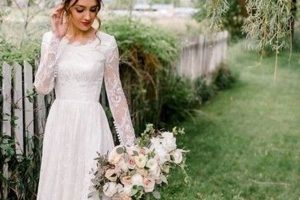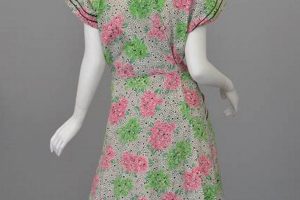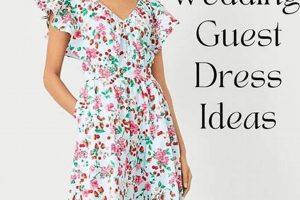Garments echoing styles from past eras but crafted with modern techniques and materials comprise a distinct segment of the wedding attire market. These gowns capture the essence of bygone decades, offering alternatives to contemporary designs. A dress with a silhouette reminiscent of the 1950s, featuring a tea-length skirt and fitted bodice, serves as one such example.
The appeal of these designs lies in their unique aesthetic and perceived timelessness. They provide an opportunity for individuality, differentiating the wearer from current trends. Furthermore, these designs often incorporate intricate details and superior craftsmanship, reflecting the quality associated with historical fashion. The emergence of this trend signifies a desire for personalization and a recognition of enduring elegance in wedding fashion.
Subsequent sections will delve into specific historical periods influencing these designs, explore available fabric choices, and discuss options for accessorizing to complete the desired aesthetic.
Guidance on Acquiring Era-Replicating Wedding Attire
The selection of attire mirroring past epochs requires careful consideration of several factors to ensure both authenticity and personal suitability.
Tip 1: Research Specific Eras: Prior to beginning the search, conduct thorough research on the stylistic nuances of different periods. Understanding the characteristic silhouettes, embellishments, and fabrics of each era will facilitate a more informed decision.
Tip 2: Fabric Selection: Opt for fabrics that accurately reflect the period being emulated. For example, silk charmeuse and chiffon are appropriate for the Art Deco era, while lace and tulle are commonly associated with Victorian and Edwardian styles. Be mindful of the drape and texture of the material.
Tip 3: Silhouette Considerations: Evaluate body type and choose silhouettes that are flattering. While a dropped-waist gown may evoke the 1920s, it may not be universally complementary. Adaptations can be made to achieve the desired aesthetic while maintaining a flattering fit.
Tip 4: Detail Authenticity: Pay close attention to the accuracy of details, such as beadwork, embroidery, and neckline styles. Inaccuracies in these elements can detract from the overall impression of authenticity.
Tip 5: Accessory Integration: Coordinate accessories with the gown to create a cohesive, era-appropriate ensemble. Headpieces, veils, and jewelry should align with the stylistic conventions of the chosen period.
Tip 6: Customization Options: Consider the possibility of customizing a contemporary gown to incorporate elements reflecting past styles. This approach allows for greater control over the final design and ensures a perfect fit.
Tip 7: Consultation with Experts: Seek guidance from designers or stylists specializing in period-inspired attire. Their expertise can prove invaluable in navigating the complexities of era-replicating design.
Adhering to these recommendations will increase the likelihood of acquiring an item that successfully captures the elegance and sophistication of a past era while complementing the wearer’s individual style.
The following sections will explore the practical aspects of acquiring and maintaining such specialized garments.
1. Silhouette
The silhouette of wedding attire, particularly within the context of designs inspired by historical periods, profoundly influences the overall aesthetic and its success in evoking a specific era. The shape and form of the dress serve as a primary visual cue, immediately conveying a sense of the past. Therefore, careful consideration of silhouette is paramount in achieving a truly era-authentic impression.
- A-Line Silhouette and the 1950s
The A-line silhouette, characterized by a fitted bodice and a skirt that gradually widens from the waist down, is strongly associated with the 1950s. This shape offers a universally flattering fit, accommodating various body types while maintaining a classic and elegant appearance. Its prevalence in post-war fashion renders it an ideal choice for replicating the bridal styles of that decade.
- Sheath and Empire Silhouettes for the Early 20th Century
The sheath silhouette, a straight and form-fitting design, is reminiscent of the 1920s, while the Empire silhouette, with its high waistline just below the bust, draws influence from the early 19th century and Regency eras. These shapes necessitate precision in tailoring to ensure a flattering fit, and their historical accuracy can significantly enhance the vintage-inspired aesthetic.
- Ballgown Silhouettes and Victorian Era
The ballgown silhouette, known for its fitted bodice and full, voluminous skirt, is directly linked to the Victorian era. The dramatic shape calls for careful structuring and appropriate fabric weight to maintain its form. Brides seeking to emulate the opulence and grandeur of the Victorian period often favor this style.
- Variations and Adaptations in Modern Designs
While adhering to historically accurate silhouettes is important, modern interpretations often incorporate subtle variations to enhance comfort and wearability. These adaptations may include adjustments to the skirt’s fullness, the bodice’s fit, or the length of the train, blending historical accuracy with contemporary design sensibilities.
The silhouette’s effectiveness in conveying a historical aesthetic depends on the interplay with other design elements, such as fabric, embellishments, and accessories. An accurate silhouette provides the foundational structure upon which the other elements build, resulting in a cohesive and convincing impression of a specific era in wedding attire. The goal is a harmonious blend of shapes that reflect both the period inspiration and the individual’s personal style.
2. Fabric
The selection of fabric constitutes a cornerstone in the creation of wedding dresses emulating historical styles. The material’s inherent propertiestexture, drape, and sheendictate not only the garment’s visual appeal but also its ability to accurately represent the fashions of a specific era. Discrepancies in fabric choice can undermine the overall authenticity of the design.
- Silk Charmeuse and Art Deco Elegance
Silk charmeuse, characterized by its lightweight nature and luminous sheen, is particularly well-suited to replicating the sleek, fluid silhouettes of the Art Deco period. This fabric drapes elegantly, lending itself to the bias-cut gowns that defined the era. Its use contributes significantly to capturing the sophistication and glamour associated with the 1920s and 1930s.
- Lace and Victorian Romanticism
Lace, with its intricate patterns and delicate texture, embodies the romanticism of the Victorian era. Whether it be Alenon, Chantilly, or Brussels lace, the selection of a specific lace variety can further refine the historical accuracy of the design. The application of lace, whether as an overlay, trim, or entire gown construction, is essential for achieving the desired aesthetic.
- Tulle and the Illusion of Volume
Tulle, a fine netting fabric, plays a crucial role in creating volume and ethereal effects in garments inspired by various periods. Its use in petticoats and skirts provides structure without adding excessive weight. Furthermore, tulle illusions in necklines and sleeves offer a subtle and delicate touch, enhancing the overall romantic appeal.
- Brocade and the Opulence of the Renaissance
Brocade, a rich and ornate fabric woven with raised patterns, evokes the opulence of the Renaissance and Baroque periods. Its use is particularly appropriate for gowns designed to emulate the lavishness of royal or aristocratic attire. The weight and stiffness of brocade require careful consideration in garment construction to ensure both visual impact and wearability.
The successful integration of historically accurate fabrics is paramount to achieving a convincing visual representation of a past era in wedding dress design. Each fabric possesses unique properties that, when properly employed, can transform a contemporary garment into a timeless reflection of a bygone era. Consideration must be given to the weave, weight, and composition of the fabric to ensure that it aligns with the stylistic conventions of the intended period.
3. Embellishments
The selection and execution of embellishments are pivotal in the creation of wedding dresses inspired by prior eras. These details transcend mere decoration; they serve as visual signifiers, immediately communicating the specific historical period a garment aims to emulate. Incorrect or anachronistic embellishments can disrupt the intended aesthetic, diminishing the authenticity of the piece. For example, the prevalence of seed pearls and delicate lace appliques is characteristic of Edwardian designs, while geometric beadwork is a hallmark of the Art Deco era. The absence or misapplication of such details would compromise the stylistic integrity.
The impact of embellishments extends beyond their visual contribution. The materials and techniques employed also play a crucial role. Hand-sewn beadwork, intricate embroidery, and the use of antique or reproduction trimmings can elevate the perceived value and historical accuracy of the dress. Conversely, the use of modern, mass-produced embellishments on a design intended to evoke a pre-industrial era could create a jarring dissonance. The placement of embellishments is equally significant. Strategically positioned accents can emphasize key design features, such as necklines, waistlines, or train details, further reinforcing the desired era-specific silhouette.
Effective use of embellishments necessitates a thorough understanding of historical fashion trends and the available materials and techniques. Replicating the specific embellishment styles of a particular period requires research and attention to detail. Ultimately, the judicious application of appropriate embellishments is essential for transforming a contemporary wedding dress into a convincing and elegant reflection of a bygone era. The meticulous selection of embellishments directly impacts the success of translating a specific period aesthetic to a wedding dress.
4. Era Authenticity
Era authenticity, concerning wedding dresses mirroring past styles, signifies the degree to which a design accurately replicates the aesthetic, construction techniques, and materials prevalent in a specific historical period. The presence, or absence, of era authenticity critically influences the perceived value and visual impact of garments inspired by vintage aesthetics. This element impacts the garment’s ability to effectively convey the intended historical reference.
For example, a gown advertised as reflective of the Edwardian era but crafted with synthetic fabrics and modern machine-stitched seams would lack era authenticity. The result is a garment which, while potentially aesthetically pleasing, fails to capture the essence of the period it intends to evoke. Conversely, a gown meticulously constructed with natural silk, embellished with hand-sewn seed pearls, and featuring lace appliques sourced from antique textiles would embody a higher degree of authenticity. This accuracy enhances the garment’s visual appeal and its value as a representation of historical fashion.
Challenges in achieving complete era authenticity arise from the scarcity of original materials and the labor-intensive nature of historical construction techniques. Modern designers often balance the desire for accuracy with the need for affordability and wearability. Adaptations may be made to silhouettes or fabric choices to accommodate contemporary preferences while maintaining the overall spirit of the intended era. The ultimate goal lies in finding a balance between complete historical replication and artistic interpretation, resulting in wedding attire that celebrates the elegance of the past while remaining relevant to the present.
5. Color Palette
The color palette significantly influences the perception and authenticity of wedding dresses designed with historical inspiration. Selection of colors appropriate to a specific era enhances the visual fidelity and accurately conveys the intended period aesthetic. Inaccurate or anachronistic color choices can undermine the overall effect, rendering the garment less convincing as a representation of the past. For example, the stark white that dominates modern bridal wear was less common in earlier eras. Instead, ivory, cream, or champagne tones were more prevalent, reflecting the natural hues of undyed fabrics or the subtle aging of textiles over time. The deliberate use of these softer, less saturated colors in a design intending to evoke a pre-20th-century aesthetic contributes to a more credible and nuanced representation.
The impact of the color palette extends beyond simply replicating commonly used shades. Subtle variations within a given color range can evoke different facets of a particular era. The muted pastels associated with the Victorian period differ significantly from the bolder, more saturated hues found in Art Deco designs. Furthermore, the combination of colors, such as the juxtaposition of blush pink with antique gold, can create a specific mood or convey a particular social message associated with a given historical context. The careful consideration of these nuances is crucial for achieving a truly authentic and historically informed design. The exploration of historical paintings, fashion plates, and extant garments provides valuable insights into the color palettes favored during specific periods, facilitating more accurate replication.
In conclusion, the color palette serves as a critical component in achieving era authenticity in wedding dresses inspired by vintage styles. The careful selection of colors, informed by historical research and an understanding of period-specific nuances, significantly contributes to the success of a design in effectively capturing the essence of a bygone era. While complete adherence to historical accuracy may not always be feasible or desirable, a thoughtful consideration of the color palette remains essential for creating wedding attire that resonates with both elegance and historical integrity.
6. Accessorizing
The selection of complementary items plays a pivotal role in completing an ensemble inspired by historical fashion. In the context of wedding attire emulating past eras, accessorizing transcends mere adornment; it serves as a crucial element in reinforcing the intended aesthetic and enhancing the overall impression of authenticity.
- Headwear and Hairstyles
Headwear significantly contributes to the era-specific aesthetic. Tiaras, jeweled combs, and Juliet caps align with Edwardian or Victorian styles. The 1920s and 1930s often incorporated headbands adorned with feathers or beads. Hairstyles must correspond with the headwear. For example, an updo complements a tiara, while finger waves pair effectively with a headband. Discrepancies between headwear and hairstyle disrupt the cohesive visual narrative.
- Jewelry Selection and Era Representation
Jewelry functions as a key signifier of historical context. Art Deco-inspired gowns benefit from geometric designs featuring diamonds and pearls. Victorian styles demand cameos, lockets, or seed pearl necklaces. Oversized, modern jewelry pieces detract from the vintage aesthetic. The metal finishes also demand attention; platinum and white gold evoke the early 20th century, while yellow gold aligns with earlier periods.
- Footwear and Fabric Compatibility
Footwear choices must complement the gown’s style and fabric. Satin pumps, T-strap heels, or lace-up boots harmonize with vintage aesthetics. Modern platform heels or embellished sandals disrupt the intended era. Fabric compatibility is paramount; silk shoes align with silk gowns, while leather boots suit heavier fabrics. The heel height should also correspond to the era; lower heels were common in earlier periods, while higher heels gained popularity in the mid-20th century.
- Veils and Train Length
Veils and train lengths must align with the gown’s era. Cathedral-length trains and elaborate lace veils correspond with Victorian or Edwardian styles. Shorter veils, birdcage veils, or mantilla veils suit mid-20th century styles. Fabric choices matter; tulle, lace, or silk chiffon are appropriate, while heavy, modern fabrics disrupt the aesthetic. The veil’s embellishments, such as beading or embroidery, should complement the gown’s details.
Careful consideration of these accessory elements ensures a cohesive and authentic representation of the chosen historical period. Incongruent accessories detract from the overall aesthetic and diminish the impact of the vintage-inspired wedding attire. The seamless integration of headwear, jewelry, footwear, and veiling completes the narrative, transforming a simple gown into an evocative representation of a bygone era.
Frequently Asked Questions
The following addresses common inquiries regarding gowns designed to evoke aesthetics from past eras. The information provided aims to clarify misconceptions and offer guidance in navigating the selection process.
Question 1: What distinguishes a “vintage inspired bridal dress” from a genuinely vintage garment?
A “vintage inspired bridal dress” is a newly manufactured garment designed to replicate the style of a specific historical period. A genuinely vintage garment is an original piece from that era.
Question 2: Is achieving complete historical accuracy always desirable in a “vintage inspired bridal dress”?
Complete historical accuracy may not be feasible or desirable in all cases. Modern interpretations often incorporate contemporary design sensibilities and prioritize comfort and wearability.
Question 3: What fabrics are most appropriate for recreating the look of specific eras?
Silk charmeuse is suitable for Art Deco styles, lace for Victorian designs, and brocade for Renaissance-inspired gowns. The selection of fabric directly impacts the overall authenticity of the garment.
Question 4: How crucial is accessorizing in completing a vintage-inspired bridal look?
Accessories constitute a critical element in reinforcing the intended aesthetic and enhancing the overall impression of authenticity. Incongruent accessories detract from the desired effect.
Question 5: Can contemporary alterations be made to a vintage-inspired bridal dress without compromising its authenticity?
Alterations should be carefully considered to preserve the integrity of the design. Modifications that drastically alter the silhouette or embellishments may diminish the garment’s historical accuracy.
Question 6: Is it possible to customize a modern bridal gown to incorporate vintage-inspired elements?
Customization offers a viable approach to achieving a vintage-inspired aesthetic while maintaining a contemporary fit and design. This allows for a greater degree of personalization.
These responses highlight the importance of informed decision-making when selecting a wedding dress that effectively captures the elegance of a past era.
The subsequent section will delve into resources available for further research and exploration of vintage-inspired bridal fashion.
Conclusion
The preceding sections have provided a comprehensive overview of gowns designed to emulate historical aesthetics. Focus has been given to the vital aspects of silhouette, fabric selection, embellishments, era accuracy, color palettes, and accessorizing. These elements, when thoughtfully integrated, contribute significantly to achieving a convincing and elegant representation of a bygone era in wedding attire.
The pursuit of gowns reflecting the elegance of the past requires diligent research and a commitment to detail. The ability to successfully capture the essence of a chosen period results in wedding attire that not only celebrates individual style but also acknowledges the enduring allure of historical fashion. As trends evolve, the demand of era-replicated designs highlights a persistent appreciation for timeless elegance in bridal fashion.







